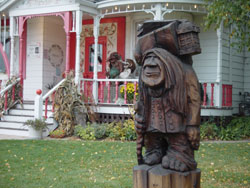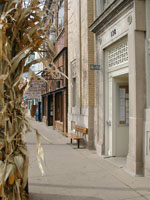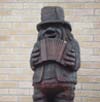





Carving Out an Identity:
Artist redefines
Mt. Horeb's Main Street
by Kelly Murray
 |
| The "Peddler Troll" toting his
wares in front of Open House Imports on Main Street. Photo by Kelly Murray |
Mount Horeb, a town just
west of Madison, is home to a small but growing population of four-foot-tall
creatures with lizard-like tails, eight fingers and eight toes.
Fortunately for the town’s 5,860 residents, these creatures come
alive only in legend. The trolls are fashioned out of logs by woodcarver
Michael Feeney, and guide tourists through the “Trollway,”
Mount Horeb’s main drag.
Trolls are mythical creatures popular in Norwegian fables, usually portrayed
as monstrous beings capable of burning bridges and poisoning wells. In
Norway, parents used the stories as scare tactics, telling their children
to hurry in to bed because the trolls come out at night.
But Mount Horeb’s trolls are meant to appear harmless and goofy—the
woodcarver describes them as “Americanized and Feeney-ized.”
The “Mayor” troll, for one, dons a snappy suit and holds the
key to the city in one hand, but tucked behind his back he’s clutching
a slingshot.
A taste of
the old country
The trolls are the most visible manifestation of the town’s strong
ethnic identity. Red flags adorn the streetlights on Main Street to proclaim
it the “Trollway,” leading visitors to the town’s small
shops and cafés—even the Grumpy Troll Brew Pub. But the Norwegian
cultural influence in Mount Horeb plays out in other ways as well.
Like many other residents, June Underwood, a “full-blooded Norwegian”
who has lived in Mount Horeb her whole life, says her family frequently
uses a cookbook of traditional Norwegian recipes, such as lefse, krum
kager, fattigman bakkels and jule kake.
 |
| Main Street in Mt. Horeb is also known as
the Trollway. Photo by Kelly Murray |
The town’s
Norwegian heritage also influences its architecture. For instance, according
to documents on the history of Mount Horeb’s Springdale Lutheran
Church, settler Aslak Lie contributed to the design of the church by modeling
the steeple, altar and windows after those he installed in his home church
in Bagn, Norway, in 1835.
The most stunning display of Norwegian architecture, however, is three
miles west of Mount Horeb in Little Norway, also called “Nissedahle,”
meaning “valley of the elves.” According to village documents
on the history of Mount Horeb, Little Norway contains original structures
from as early as 1856, complete with antique furnishings. The buildings
give visitors a feel for what life was like for the early settlers. A
popular attraction at Little Norway is a large building modeled after
the Stavkirke, a church from 12th century Norway.
Little Norway was also the first location to display the now-pervasive
trolls. Feeney began making the trolls for the town 14 years ago because
leaders saw them as a way to celebrate Norwegian cultural identity and
draw in tourists. Many tourists pick up a visitor’s guide from the
Chamber of Commerce so they can take the “Troll Stroll” with
a map showing 12 locations of Feeney’s trolls.
Dru Pachmayer, executive director of the Mt. Horeb Chamber of Commerce,
says Feeney’s trolls have “added a unique persona to our town.”
She says people visit Mount Horeb for a variety of reasons, but the trolls
have a particularly magnetic attraction.
The
creation of an icon
Feeney does most of his work on a troll with a chainsaw and chisel but
says he’ll also use just about anything that will give it a unique
texture. He’s tried several different types of wood but prefers
the black willow because it has a rich, orangey color and has fewer cracks,
or “checks,” than other varieties. Whether the log contains
checks is an important consideration—one cutting through a troll’s
face is particularly unacceptable, Feeney says. “That would be positively
bogus.”
The trolls’ admirers might wonder what a guy with a blatantly Irish
name like Michael Feeney is doing fashioning characters out of Norwegian
fables. Feeney says he carved such mythical creatures as wizards, gnomes
and trolls for art fairs. Someone from Mount Horeb liked the troll, and
the design snowballed from there.
Feeney has lived in Mount Horeb for 23 years. He has a wife, attorney
Pamela Lunder, and a son, Erin, who is a junior at UW-Madison. Lunder
says one of the things that attracted her to Feeney the most was his strong
sense of humor, and she says that’s something he always tries to
incorporate into his art.
“Artists always sort of look for a shock value one way or the other.
Some do it by being graphic, and some do it by being violent or depicting
different things. To Mike, his shock value is trying to get a smile, a
smirk, a giggle, a laugh out of somebody. If they just look at it and
have no reaction, that’s hard to take,” Lunder says.
Feeney insists his home is “almost normal”—that is,
not filled with armies of wooden trolls. But though he might be able to
physically separate his creative space from home by carving in a workshop
in town or on location, Lunder says the wheels are always turning.
“He is his work,” she says. “We can be sitting at a
restaurant, and God forbid we go to these places where they put paper
over the table … and they give him crayons and the whole top is
covered [with drawings]. But he gets a napkin, and he’ll see somebody
over to the side that has a really good profile or interesting body characteristic,
and he’ll be scribbling away!”
 |
| The Transfer and Storage Troll has an unusual
method of transferring. Photo by Kelly Murray |
Feeney says seeing
unique features in people that he can build into his carvings helps keep
the work interesting. And although he’s been making trolls for the
town for 14 years now, the 57-year-old says he’s not sick of them.
“I continue to do them because they amuse me, and I think it’s
because people amuse me,” he says.
New ideas keep him energized, but when he finishes a project it’s
almost as though he can’t stand to look at it a second longer. When
he drives down the Mount Horeb Trollway, he says, he makes a conscious
effort not to look at his trolls. “It’s kind of like when
a snail crosses your driveway in the morning and it leaves this trail
of slime—the trolls are kinda the slime,” Feeney says. After
investing so much energy into one statue, he wants to wash his hands of
it and move on to the next.
Feeney turns out about eight to 10 major pieces a year, with smaller pieces
sprinkled into his schedule as well. Private parties purchase much of
his work, but most of the trolls visible around Mount Horeb were purchased
in part by the town. Feeney charges anywhere from $3,000 to $15,000, depending
on the project. The most expensive was a massive $20,000 sculpture of
trolls fishing, now on display in the local school.
Branding
the town
Pachmayer says the trolls are a tremendous benefit to the town. “Mike’s
trolls give us a brand—a way to market ourselves,” she says.
She says the money to buy the trolls comes from Chamber of Commerce member
dues, donations by the village and events like Mount Horeb’s annual
art fair.
Janice Sivers, a buyer and sales clerk at Open House Imports, a small
shop on Main Street, says the majority of people who stop to examine the
“Peddler Troll” in front of her store end up coming in to
look around. The tourists enjoy the troll, she says, and ask questions
about it. Sivers says Open House Imports paid for the log and the installation,
while the town paid Feeney for his work.
The “Peddler Troll” is a humble-looking fellow with a plethora
of packages on his shoulders and a Norwegian rat hiding out behind him.
“The Peddler was the first troll to visit Mt. Horeb, you know,”
Sivers declares. “He scoped it out, then went back to Norway and
told all the other trolls to come.”
Sivers thinks the Peddler has found a fitting home. “I guess [Feeney]
figured, since we’re merchants, the ‘Peddler Troll’
would look best on our lawn,” she says. “He is very talented.”
Feeney’s artwork is accessible, but the locals aren’t likely
to assert that they could do what he does with a chainsaw and a chisel.
In this town, he’s something of a legendary character himself. “When
people find out that he’s the troll carver, they get sort of awestruck,”
Lunder says. But that’s the last thing Feeney wants. He implores
his fans to keep things in perspective.
“Mick Jagger is famous,” he says. “The Troll Guy is
not famous.”
